Ok. What about this one: "NATO had no “first strike” doctrine (unlike the Soviets…), "
Where was the NATO’s “no first strike” doctrine defined? How do you know that Soviet’s did nave “first strike” doctrine?

Ok. What about this one: "NATO had no “first strike” doctrine (unlike the Soviets…), "
Where was the NATO’s “no first strike” doctrine defined? How do you know that Soviet’s did nave “first strike” doctrine?
Oh, not in the least - most empires act like that with “native” troops they don’t fully trust, see for instance the way the Indian army was officered and equipped prior to WW2.
However, the point I was trying to make in there was that during the Cold War the communist states tended to behave like this (military forces more competent than those directly loyal to Moscow or Peking being regarded with extreme suspicion), but that with a handful of exceptions the US was always encouraging it’s allies to become more effective militarily.
I am not saying that this point makes no sense. To certain degree it was true. But I think the extend of this is normaly much overestimated.
The east european socialist countires were only partly controlled by the USSR’s goverment. They had a great deal of freedom to dowhat the local burocrats wanted.
Anyways, do you have any specific info about how Soviet goverment kept down the development of other East European armies?
And by the way, what was that you saw in that booklet about Czheck army that showed it’s incompetence?
No. Think German invasion of France in 1940, only, this time, NATO plays the part of the French that are cutting off the overextended and exposed supply lines of the German salient rather than allowing themselves to be cut off and annihilated in set piece battles…
An over simplistic take of my amateurish knowledge of tactic’s, but I think that’s pretty much it…
Of course, the Soviets were never much about logistics; one of the problems they had after invading Afghanistan…
Only if everything else failed. NATO became a bit more optimistic towards the end of the Cold War…
Some ever estimated that the qualitative advantage in AFVs gave NATO an overall advantage of 1.1 to 1 in tanks, even though the Soviets vastly outnumbered them…
Of this all is a wee bit mute as Soviet battle plans always included liberal amounts of Nuclear and biological weapons. So any wr scenario would have quickly turned into global annihilation.
What Soviet battle plans? Do you have any refferences?
Indeed - it was clearly in the Soviet interest that the Warsaw pact states were at least partially competent militarily. However, the Brezhnev doctrine (that Soviet troops would intervene militarily in those Warsaw Pact states that didn’t behave themselves as judged from Moscow) requires that these Warsaw Pact troops be unable to stand up against the Red Army in a straight fight.
Agreed. My perception is that Moscow set limits within which they were allowed to pretty much do what they wanted. Hungary in 1956, Czechoslovakia in 1968 and Poland in the early 1980s demonstrated what would happen if they went outside these limits and tried to form their own policies.
General, not specific. Examples would be the way that manufacture of Main Battle Tanks outside the Soviet Union was always of slightly older designs - Poland for instance started producing T-72 derivatives (with slightly less advanced armour than the Russian model) at a time when the Soviets were starting to make the T-80.
I wasn’t claiming incompetence, rather that about all you can tell from the photos is that their marching wasn’t up to scratch. The photos from in the field are blatantly posed - there is no way an army would act like that facing real opposition and survive very long.
Tanks right next to each other with a handful of infantry running behind. Looks great, but there is no way you would do that in reality. The tanks have come through a very large piece of open ground (which any defender would select as their “killing area”), there are too few infantry to provide any meaningful support, and the tanks are so close together that they’re a dream target for artillery.
The infantry are getting out of their armoured carrier having apparently just crossed a ridge line (rather than getting out in dead ground where they won’t be shot). They also appear to be carrying their full marching order straight into a firefight, rather than just their fighting order.
Camouflaged gun positions, but with a blindingly obvious white road leading up to them? What the f***?
Personally, I think these shots were all set up by the local propaganda service, and don’t represent in any way the reality of the army. Which is what I was trying to say in the first place.
Exactly!  Which makes all your reasonable points like “tanks right next to each other” and “with a blindingly obvious white road leading up to them” irrelevant, I am afraid…
Which makes all your reasonable points like “tanks right next to each other” and “with a blindingly obvious white road leading up to them” irrelevant, I am afraid… 
There have been mentioned American financial help programs in this and other threads.
Having sertain respect and acknoledging positive impact on other countries that that help provided I, nonetheless, would like you to take a look at this scan from the book “Hvad-Hvem-Hvor 1964” printed in Denmark. It is a yearly facts collection catalog that is being issued every year up until these days.
I would like to show you 2 scans from that book.
[ol]
[li]The first one shows the Foreign Aid provided by the USA and USSR to other countries during the period of 1955-1959.[/li]USA - green, USSR - red. The size of the figures represent the amout of help. As you may see the USA’s help is larger, but the USSR’s help is also very sizeable. I would gess Soviet aid is about 1/3 of the USA’s or so.
In the low left corner the diagramm for the USA foreighn air for the period 1945 - 1962, split on military aid (brown) and civil aid (yellow).

[b]click to enlarge (120kb)[/b]
.
[li]The second one is desposition of the West and East forces in the early 1960s.[/li]In the left dowd corner you can see the balance between different forces.
The Soviets have certain overal quantitative advantage but are probably lacking in quality. And if you also remember that USA by 1964 had 5 times more nuclear charges than USSR, then the the balace forces will be more or less apparenet.

[b]click to enlarge (180kb)[/b]
[/ol]
It is not the world’s best source of info but interesting nonetheless.
Sorry, you misunderstand me. I was trying to show that the photos were propaganda shots to support my original contention that they were “Nice photos, even if they don’t show the Czechs being able to do much more than march badly…”.
What I meant by that is that they didn’t provide any useful information beyond the fact that the Czech army was marching slightly out of step in one parade.
This photo album was dedicated to 30 years anyversary of the Czheck People’s Army. Issued by the “Beuro for Political Propaganda” in 1975. So what else do you want? It is a retorical question… 
Sadly I don’t speak Russian and judging by the script all the comments on that page were in Russian. Bit tricky for me to figure that one out then…
Czheck People’s Army
Please type word “Czech” in correct form. Until 1993 our army was called Czechoslovakian People Army (Československá lidová armáda - ČSLA).
These color photos of CSLA are of course propagandistic.
Not to mention that the tanks are running straight ahead.
Easy targets.
Support? One or two rifleman per tank? Hardly worth an attack, is it?
There are all sorts of reasons for leaving a vehicle in a hurry, many not tactically ideal, but having spent a bit of time in the back of Saracens among other beasts that aren’t that dissimilar to the vehicle above, I can say that if you can get your troop / section whatever it’s called out of it in a sufficient hurry with your weapons and webbing to form a firebase to respond to a serious, well planned and well executed attack and or before your vehicle gets brewed up, you are doing well.
If you can get full marching order into a Saracen, never mind out of it in a hurry, you’re a champion.
And I recall this with some clarity as a trooper in a Saracen going over a shabby rural bridge prominently signed that it was rated at about one fifth of the weight for the vehicle, while a certain officer who liked to present himself as heroic stood on the roadside, after carefully leaving the Saracen we were in before giving his heroic order to cross the bridge to add to his heroic reputation for deeds of derring do. None of which involved him risking his shrivelled little nuts.
Funny thing is, it was about that time that I resolved that if in the highly unlikely event the army was sufficiently stupid to send us to war, Captain X was going to be my first target, closely followed by Corporal Y if he didn’t wake up to himself. Even funnier, much of my whole armoured unit came independently to pretty much the same view, although not always involving the same targets.
So sorry, honorable ladies and gentlemen – I have had some urgent official duties. Nevertheless – here are my replies:
Word “only” was hyperbolic, i mean five-year plans, major part of indusry were waepons, tractors(and other farm machinery and vehicles), simply heavy industry no matter the needs of market. Tatraplan was one of the best Czech post-war cars(with 603, 813 and some cars made in 50’s). Other cars made in age of communists (Škoda 1000, 100, 105, 120…)were perturbative, poor quality cars…
Indeed, my dear Mr. Fiala – hyperbolic it surely was, to say it mildly. But this utterly fair answer of yours testifies that a strong devotion not to be huddled in an appealing, comfortable, and so sorrowfully widespread cocoon of intellectual hibernation is highly vivid, and that fact deserves an unrestrained public admiration. I wish you many happy returns! 
Additionally, allow me, please, just a few tiny remarks about some common mistakes connected with Czechoslovakian production of material goods. It has to be mentioned that industrial production in your country was very well balanced and truly diversified – list of industrial products encompassed more than 76000 different commodities, starting with airplanes and concluding with crystal water glasses – with a rationally calculated aggregate supply rate of all goods.
On the subject of your conclusion with reference to the quality of Czechoslovakian post-war cars, I have to say that I am in complete agreeableness with you regarding qualities of Tatra 600 Tatraplan. However, by my personal opinion, the best car produced by renowned Tatra národní podnik – Kopřivnice is the following one:

Tatra JK 2500
This magnificent prototype was made in 1956. Alas, it never came to production. What a pity for this miracle on wheels, constructed by talented engineer Mr. Julius Kubinsky, and completely capable to achieve maximum speed of 207km/h (130mph).

Tatra JK 2500 – Czechoslovakian automobile challenge for the eminent Alfa Romeo 6C 2500
And no, my dear Mr. Fiala – those other cars that have been produced in communist age were not poor quality ones – on the contrary, they were capable to do their transportation tasks reasonably well It is less known that, for example, Škoda 440 Spartak successfully and profitably entered even a choosey and conceited US market, and effectively passed all US governmental attestations.
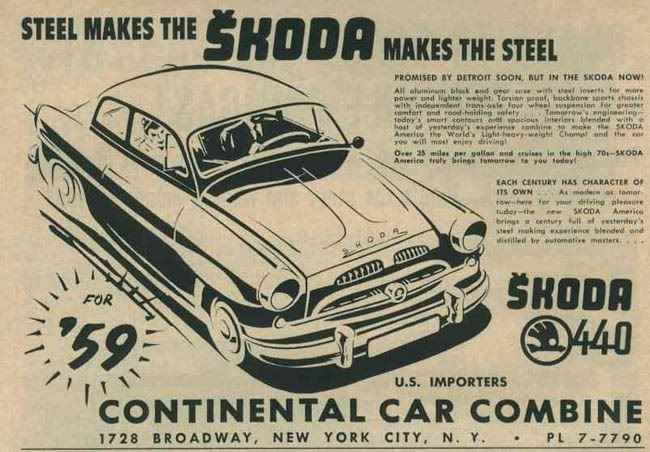
Škoda 440 – Spartak, US commercial

Škoda 1000 MB – Norwegian Trailer
Unlike Japanese and some European cars imported into US during the late sixties and early seventies, Škoda’s were not junk cars with, for example, multiple brakes failures and a rust weakened chassis, like Datsun 240 Z, or horrifying exemplars of constructive irresponsibility in the North American car production, like domestic junk-small cars – Chevy Vega and Firenza, Chrysler’s Omni and Horizon, or Ford Pinto and Bobcat. Yes, I know, my dear Mr. Fiala – Škoda was not a substitute for the Mercedes Benz, but you are too young to be acquainted with the fact that, for example, US born Ford Pinto was widely known back there in the States as Ford’s rolling Molotov Cocktail, catching fire and trapping occupants when hit from the rear. And you also don’t know that officially proven fact was that Ford knew of the danger but bowed to its accountants who figured it would cost less to stonewall each future death and burn injury then to recall and redesign the fuel tank. But don’t worry, if you wish this old fool will inform you about immortal achievements in an industry known for its dishonesty and exaggerated claims.:roll:
You don’t have to believe this, but those “commie” engineers in Mlada Boleslaw were, as a matter of fact highly original. This construction, for example, with internal code HF55-57100 RS, was pronounced the Engine of the Year in a 1000-1300ccm category by notorious Swiss auto-magazine “Automobil Revue – Revue Automobile” and employed in Skoda “1101 typ 968” coupé.
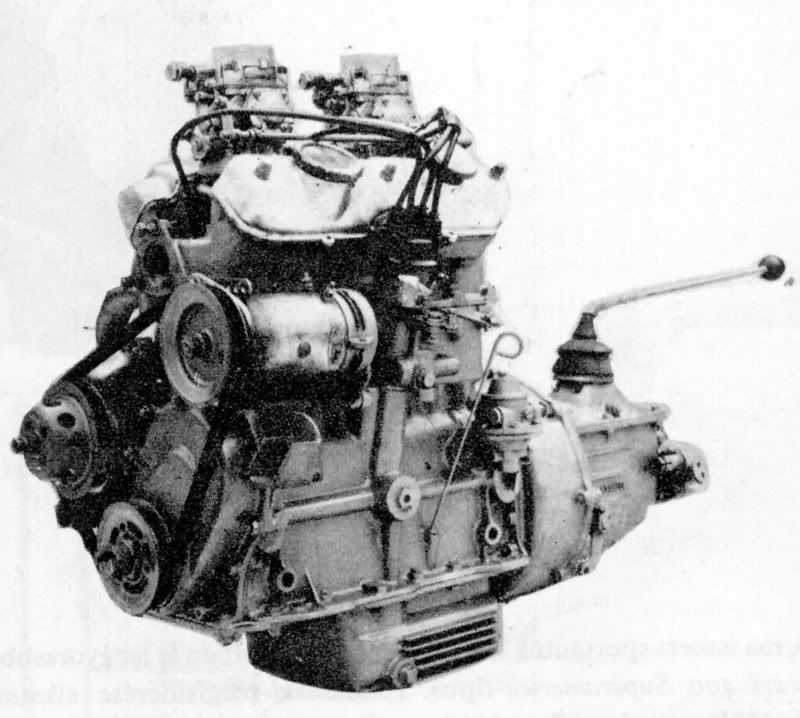
Skoda HF55-57100 RS – 1100 ccm, 4 cylinder DOHC, compression ratio 12,2:1 - 92 HP
Another fine example of the Czechoslovakian designing ingenuity was this Skoda “Super Sport 1100” from 1971 - a sport coupè with liftable roof and with the engine of the “S-110R” (1107 ccm, 80 HP at 6000 RPM, maximum speed of 180 km/h).
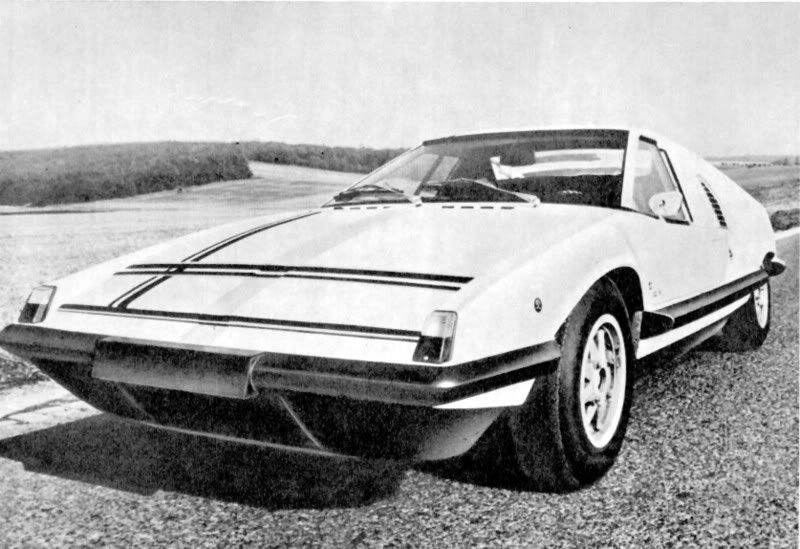
Skoda Super Sport 1100
Not even to mention this anticipated “BMW and Alfa-Romeo competitor”, the one and only Škoda 720.

Škoda 720 (4 cylinder, 1997 ccm OHC engine, 160 HP/6000 RPM, 210Nm/5000 RPM) - Alfa z Boleslavi
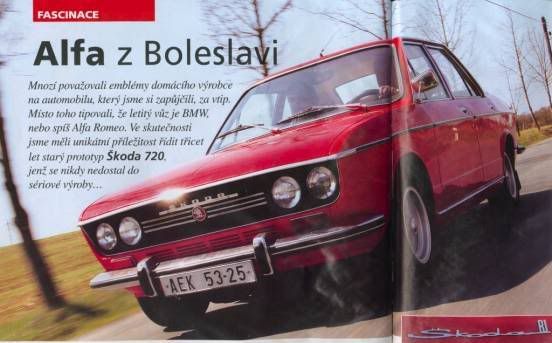
Škoda 720
Poor quality cars? No, my dear Mr. Fiala – just a vast quantity of uncertain information environments about Czechoslovakian cars. That’s all. 
And yes – please, reconsider some possibilities for the change of that unambiguous message in your signature. Although our distinguished colleagues here are most probably not familiar with the meaning of that inscription “Smrt komunistum” (Death to communists), I am sure that aforesaid proclamation is not very popular among them.
In the meantime, as always – all the best! 
Nothing of the sort. Before collectivisation the USSR was the main exporter of agricultural production with the same problems of adequate mechanization and chemization but after collectivisation the agricultural output started to decline.
The main problem with this normative stance of yours, my dear Mr. Kato is the fact that the USSR was even larger exporter of agricultural products (primarily grain) after the collectivization. If you don’t believe this just take a look upon this diagram:

Grain Export, USSR
(Nove, A.: An Economic History of the USSR. Penguin Books, 1990.)
As we all know from our curriculum in Macroeconomics, if domestic aggregate demand of a given country is sufficiently suppressed due to different socio-economic reasons, mainly manifested in inadequate price-wages level, consequential misbalance in aggregate supply-aggregate demand equilibrium always will be balanceable by overseas export of domestic goods, no matter how immensely or exiguously production level of specified material goods actually is situated within the country.
So what actually happened? In 1928 Stalin began a series of five year plans to industrialiye the country. The aim of the five year plans was to build up heavy industry (steal, coal, machinery). Under the plans completely new, previously completely unregarded areas of the Soviet Union were developed. New industries such as energy, chemicals, and the production of military equipment were successfully established.
While over 1500 new factories and several new cities were built under the First Five Year Plan (1928-1932), the plan was completed at great cost to the Soviet people. To industrialize the country, the plan needed great amounts of money and equipment, which the war-devastated country did not have. The only way to obtain the necessary money and industrial machinery demanded by the plan was to increase the country’s exports of grain, timber and minerals to the West, unfortunately at a time when grain prices were very low because of the depression in the West. Now more grain would have to be exported to pay for the same quantity of equipment.
To keep up industrialization more capital was needed. To obtain it Stalin ordered more grain to be squeezed from the country. Since the end of the WW1 western per capita production of the basic starches, the “stuff of life” has risen by more than one fourth in industrialized West, it - alas! - declined in the Soviet Union, due to insufficient capital investments in agricultural production.
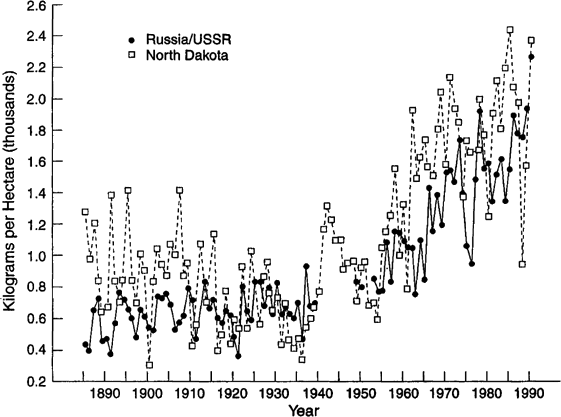
Wheat yield, Russia/USSR and North Dakota, 1885–1990.
(A Reassessment of the Soviet Industrial Revolution, Robert C. Allen)
The quickest way to do this was to nationalize the land and to move the peasants onto collective farms, where very limited amounts of modern machinery, so desperately needed for augmentation of the domestic production, were available. Consequences of this effort are observable on the previously presented graph.
This process began in the autumn of 1929. By February of 1930 all peasant households, including livestock, were collectivized. Unfortunately, collectiviyation unleashed wide and ferocious resistance. It sounds completely insane, but peasants even slaughtered their livestock and burnt their crops rather then surrender them to the state. The number of horses, for example, declined from 4.4 million in 1928 to 2.6 million by 1933. Cattle declined in the same period from 8.6 to 4.4 million. Soviet agriculture had always been short of draught animals. The production of tractors was in its infancy and could not replace completely needed animal power, besides, due to heavy operating conditions they were constantly braking down, without sufficient amount of spare parts for repairs. And to add to all these difficulties, a drought hit the country. It began in late 1931 and it was the most severe in the steppes.
The factors that have been mentioned previously contributed to the so called Great Famine of 1932-1933. However, it has to be mentioned that even in succeeding years, when modern agricultural equipment was available in greater quantities, problem of insufficient grain yield persisted.
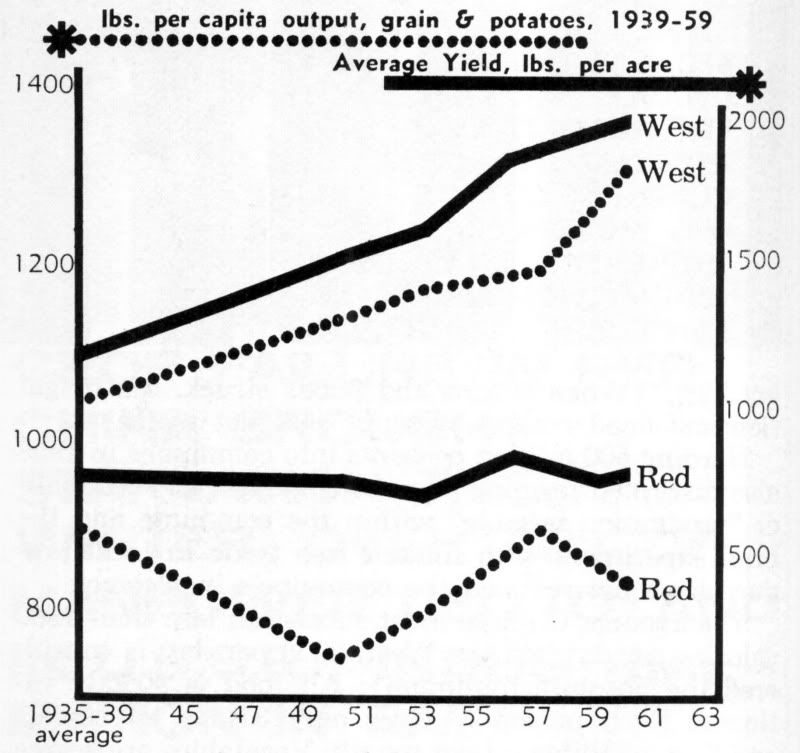
Average Grain Yield
Western grain yield per acre has swelled from a pre-WW2 average of a little over 1200 lbs to a 1960 average of well over 2000 lbs, while Soviet yield has virtually marked time, rising from 740 to 775 lbs. Of course, proper solution was envisioned, but in early 1950’s accent was set on reconstruction of the urban and production facilities.
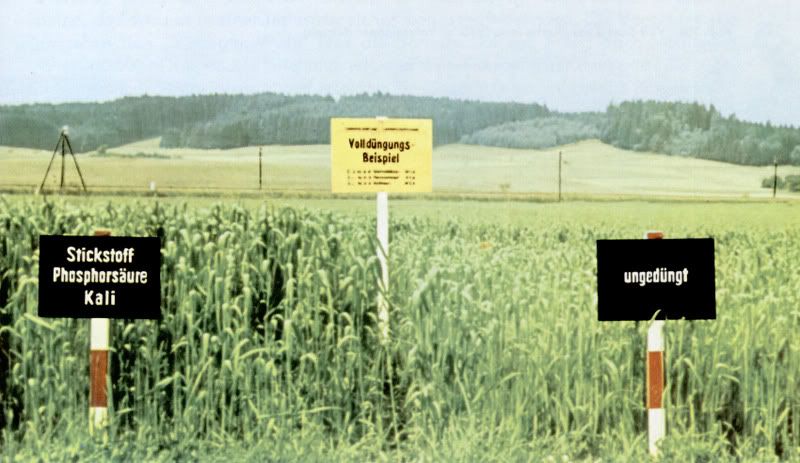
Effects of Agrochemization upon wheat Yield- DDR, vicinity of Malchin, Mecklenburg
Because the USSR has been unable to raise output per acre due to insufficient capital investments in irrigation and chemization, because of reinforced obligations toward rebuilding the country’s towns and villages that had been destroyed in the WW2, it tried to increase its total agricultural output by bringing more acres into use.
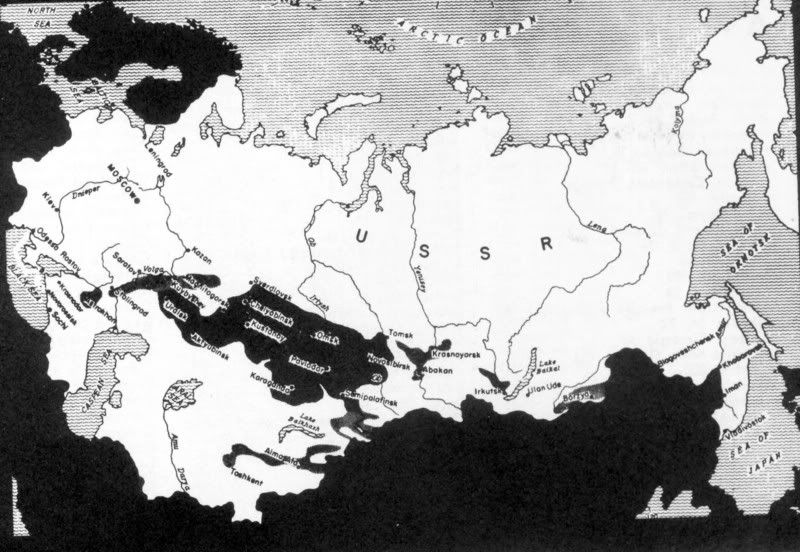
Virgin Land Scheme
However, Khrushchev’s 100-million acre “Virgin Land Scheme" (Included in the dark outlined at right) has suffered three straight droughts (another indeed brilliant example of the importance of irrigation, as a capital investment in agriculture)! These marginal lands were intended to concentrate on wheat, while the older and richer farmlands to the West were intended for more intensive, previously neglected industrial crops. That chapter of the Soviet agricultural production, however, that is a completely different story… 
Sorry, honorable ladies ang gentlemen - another brake of the post. This is the very reason: The text that you have entered is too long (13447 characters). Please shorten it to 10000 characters long.
Oh, no problem - to be continued…:roll:
The Soviet Union had a different ideological and economic system opposing to the one of the US. So if it had really tried to copy something it would have had to begin with converting state property into private one and not vice versa.
On the contrary, my dear Mr. Kato – industrial development of the Soviet Union represents a bold example that issues of ideology and ownership are absolutely irrelevant factors in a scientifically based system of material production. 
The most magnificent but generally unspeakable story of the XX century is the historical fact that in the first two decades of it progressive intellectuals in two completely different part of the world actually enlarged on the XIX century identification of technology and scientific rationality with the fulfillment of the immanent American and inherent communistic dream. The new century, both in Russia and America seemed to offer bold new prospects, vistas previously hidden in the pessimistic and chaotic nineties.
Such optimism was grounded in the view that the newly emerging industrial state and the corporate organization of production could be directed by man’s rationality to bring a social reformation where poverty, injustice, superstition, and class conflict would be abolished. While representatives of American Progressivism - today almost completely forgotten American social movement - disagreed with European socialists over whether Her Majesty the State, or Her Highness the Corporation represented the proper institution to organize the new, rationally based human society, they agreed that only centralized nation-wide direction under the guidance of experts could assure what Herbert Croly termed the “true promise of American life – the promise of the Allmighty Providence that we have not gathered together here in vain, just to share our misery, but to produce material abundance for ourselves”.
One logical conclusion of the implications of progressivism, and scientific management of the society, found its clearest expression in the writings of an American socialist – Thorstein Bunde Veblen. Contrasting the rationality he saw in mechanical industry with the chaos and selfishness he found in finance capitalism, he became a devastating critic of business enterprise.
Veblen believed that technology was creating values counter to those of conspicuous waste, which governed the leisure classes. He preached that possessing a concern for the community’s material welfare, as well as an instinct for efficient workmanship, scientists and engineers are capable to offer hope for a better social order. Veblen concluded with a call for engineers to control the economy, to clean the political system of corruption and to make it responsive to the needs of community.
]
It sounds pretty strange, my dear Mr. Kato, but although American Progressives and Russian Bolsheviks disagreed on precisely what the national needs were, they shared the conviction that politics had become thoroughly corrupt, dominated by greedy bosses and weak, incompetent elected officials. Such man either exploited the community in their own right or were fronts for the self-interested Robber Barons of big business.
American populist school of thought intended to expand direct democratic participation in politics. Russian view was to shorten the ballot and expand the power of the executive administration. The intellectuals generally favored the latter approach.:roll:
In the reformed state they envisaged, the exercise of decision-making power would be largely removed from the corruption of policies or the mercy of fortune, and transferred to expert public servants. The experts, once and for all divorced from political vicissitudes could then freely exercise their rationality – the very basis of the efficient production. They would be able to efficiently administrate the planning activities of the state, and to bring trained intelligence to social problems in a manner that mere politicians were incapable of doing.
In the reformed state he envisaged, the exercise of the apolitical, scientific knowledge about different factors of production will produce a rapid industrial development, higher standard of living and satisfaction of human material needs.
Yes, I know, my dear Mr. Kato - all this sounds pretty strange, but fortunately we have some firm evidence that never officially recognized, but always strapping mutual affection between the USA and the USSR actually was able to triumph over those fabricated societal differences amid them. Please, just read these lines:
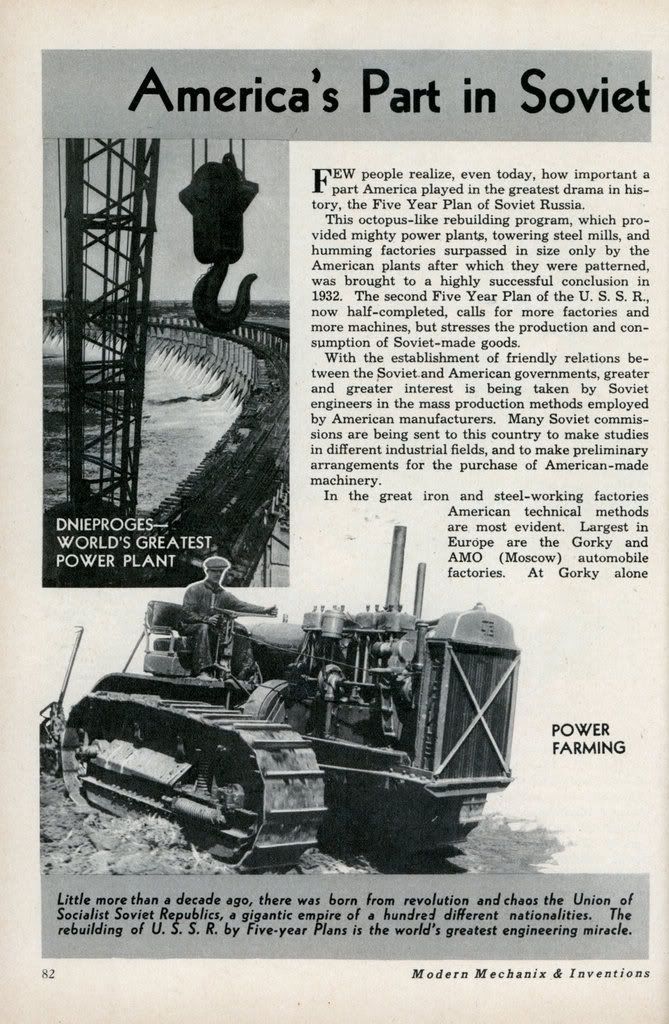
Modern Mechanix, 1935 – Soviet Development 1
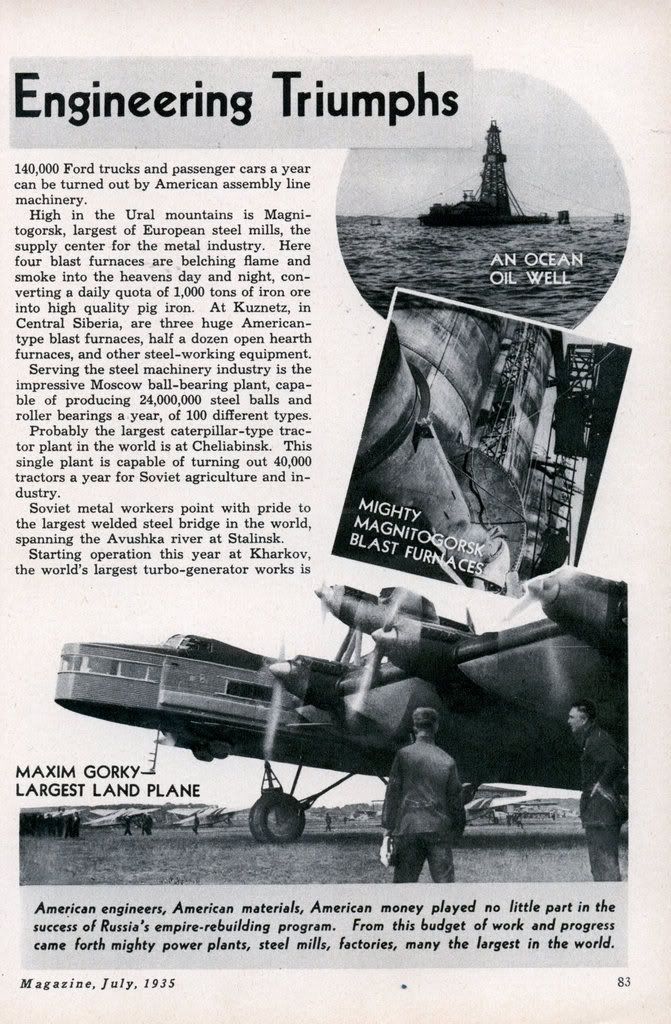
Modern Mechanix, 1935 - Soviet Development 2
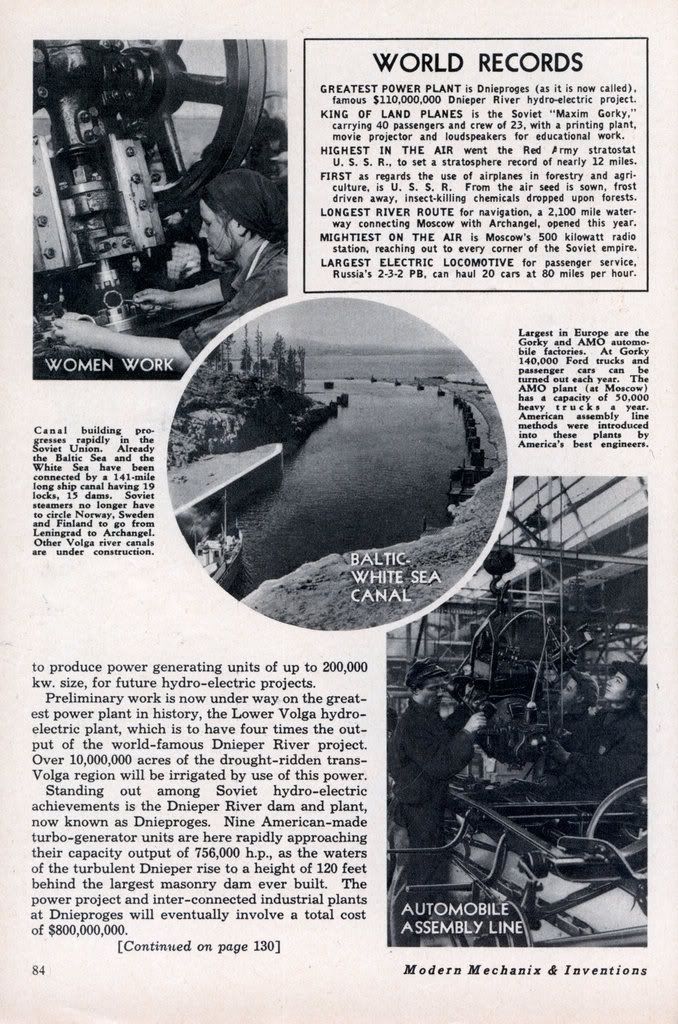
Modern Mechanix, 1935 - Soviet Development 3
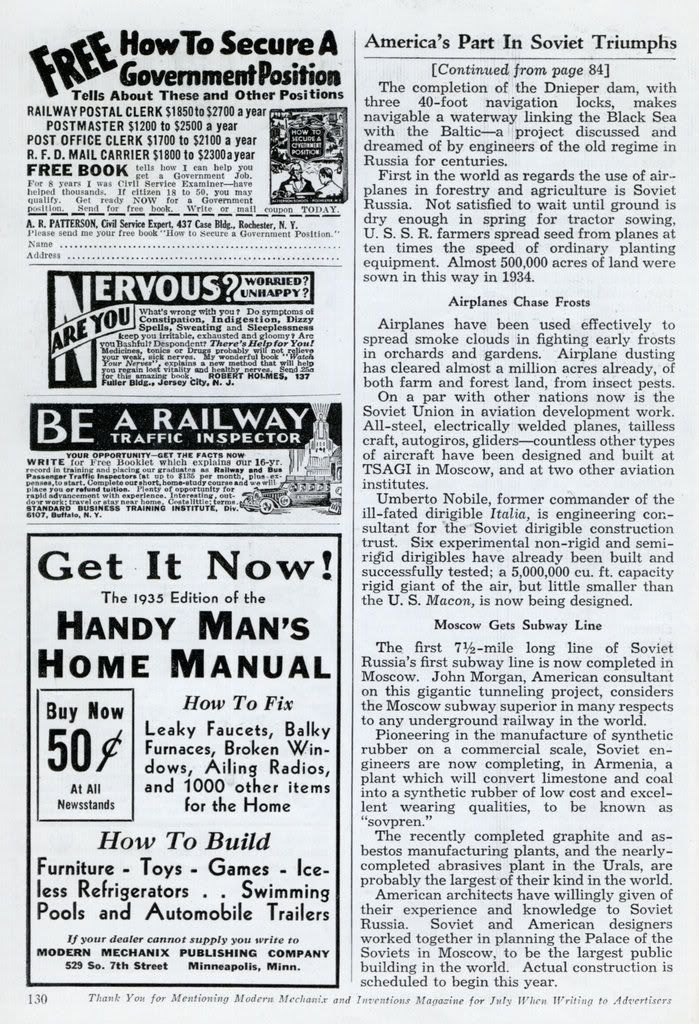
Modern Mechanix – Soviet Development 4
Holly Smoke, my dear Mr. Kato - the world’s largest automobile plant? In the Soviet Union? In 1930? Designed and engineered by The Austin Company in Cleveland, from the US of A? Constructed under Austin engineers supervision by thousands of Russians? For which Austin was paid in solid gold? This sounds like the stuff of legend and myth - yet it is all true, and the history is indeed more remarkable than all the bits of the story passed down to us.
As part of his first Five-Year Plan to industrialize the USSR., Stalin sought to develop the Soviet auto industry, and he determined that the country needed a modern plant to produce automobiles for the Soviet Union. And yes again, my dear Mr. Kato - the model he chose was the production line of Henry Ford, the ultimate capitalist! In 1929 Ford signed an agreement to sell the Soviets plans, specifications and methods for design and production of trucks and cars and to provide vehicle parts for assembly in the first years of the plant’s operation as well!
For design and construction of the plant, the Soviets turned to The Austin Company, which had just completed the Pontiac Six factory, the largest auto plant in the world at that time. Austin’s task was to design and manage construction of both a factory capable of producing 140.000 vehicles a year, as well as a model socialist city (sic!) for 35.000 workers and their families - all within 18 months.
To supervise construction of the plant and workers city, Austin sent 20 engineers (several with their families!) to Nizhny Novgorod, a city on the Volga and Oka Rivers 250 miles east of Moscow. Construction began in May 1930 and was completed in November 1931 - an amazing feat for which Austin was paid $1,550,000 in gold - a payment that saw the company through the lean years of the Great Depression. The Austinites returned home, and in January 1932, the first Model A rolled off the production line.
Do you still think that undefeatable ideological and economic societal divergences are so overwhelmingly fundamental in this world of ours, my dear Mr. Kato? If so – think again. You see, previously presented historical miracles are not the unaccompanied ones! 
To be continued…
The goal was to prevent the possibity of “counter-revolution” and crack down nationalism. This goal was openly declared in the communist party meetings and its official documents…
Sorry, my dear Mr. Kato, but as far as I am capable to read and to understand Russian language, explicitly manifested social goal, presented in this most important party document - Programme of the RCP(B) - first published in 1930, explicitly declares this:
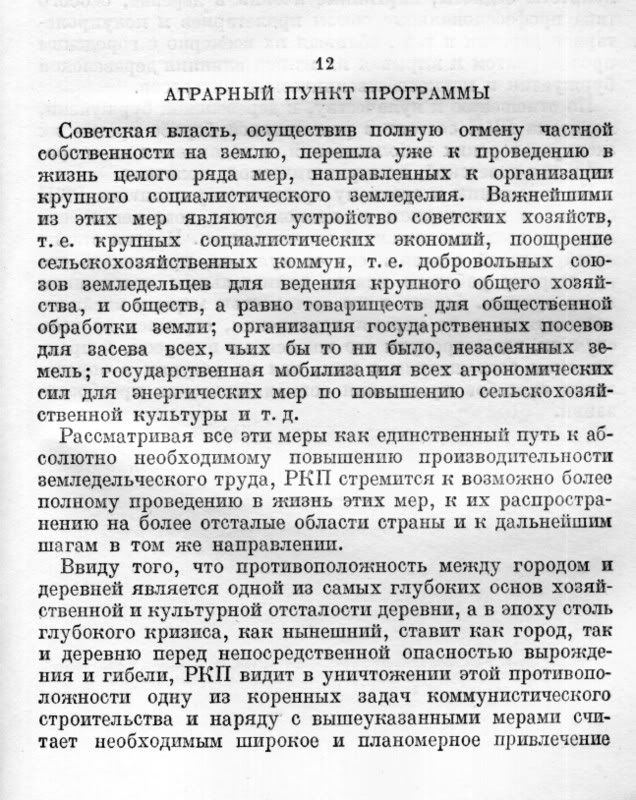
Programme of the RCP(B) toward agricultural development- page one
“After the abolition of private property in land and after the almost completed expropriation of the landowners and the promulgation of a law on the socialization of the land, which regards as preferable the large-scale farming of commonly-owned estates, the chief task of Soviet power is to discover and test in practice the most expedient and practical transitional measures to effect this.”
“The main line and the guiding principle of the R.C.P. agrarian policy under these circumstances still remains the effort to rely on the proletarian and semi-proletarian elements of the countryside. They must first and foremost be organised into an independent force, they must be brought closer to the urban proletariat and wrested from the influence of the rural bourgeoisie and petty-property interests. The organisation of Poor Peasants’ Committees was one step in this direction; the organisation. of Party cells in the villages, the re-election of Soviet deputies to exclude the kulaks, the establishment of special types of trade unions for the proletarians and semi-proletarians of the country-side-all these and similar measures must be effected without fail. As far as the kulaks, the rural bourgeoisie, are concerned, the policy of the RCP is one of decisive struggle against their attempts at exploitation and the suppression of their resistance to Soviet socialist policy.”
“As far as the middle peasant is concerned, the policy of the RCP is one of a cautious attitude towards him; he must not be confused with the kulak and coercive measures must not be used against him; by his class position the middle peasant can be the ally of the proletarian government during the transition to socialism, or, at least, he can remain a neutral element. Despite the unavoidable partial failures and waverings of the middle peasant, therefore, we must strive persistently to reach agreement with him, showing a solicitous attitude to all his desires and making concessions in selecting ways of carrying out socialist reforms. In this respect a prominent, place must be given to the struggle against the abuses of those representatives of Soviet power who, hypocritically taking advantage of the title of Communist, are carrying out a policy that is not communist but is a policy of the bureaucracy, of officialdom; such people must be ruthlessly banished and a stricter control established with the aid of the trade unions and by other means.”
Insofar as concerns measures for the transition to communist farming, the RCP will test in practice three principal measures that have already taken shape-state farms, agricultural communes and societies (and co-operatives) for the collective tilling of the soil, care being taken to ensure their more extensive and more correct application, especially in respect of ways of developing the voluntary participation of the peasants in these new forms of cooperative farming and of the organization of the working peasantry to carry out control from below and ensure comradely discipline."
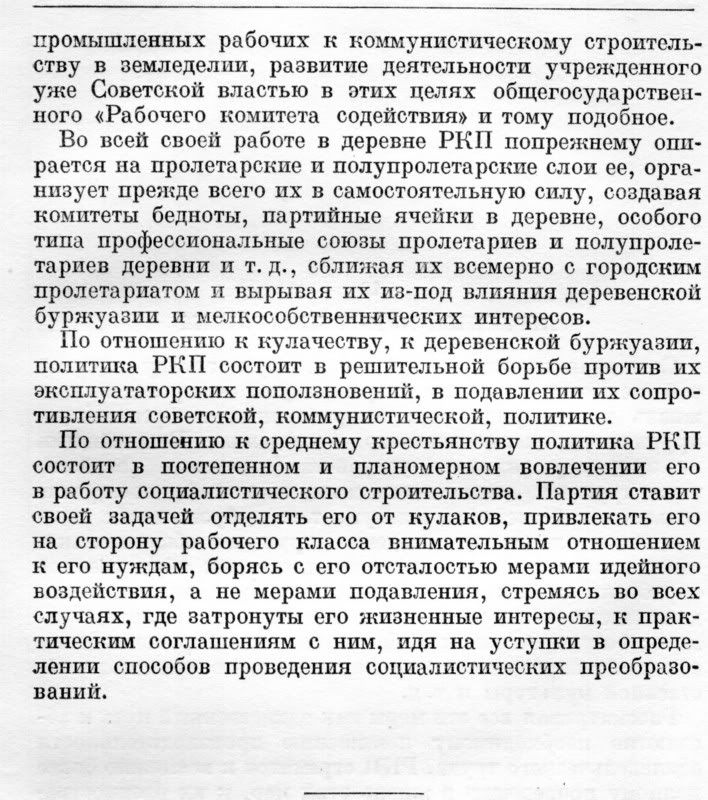
Programme of the RCP(B) toward agricultural development- page two
“The RCP food policy upholds the consolidation and development of the state monopoly, and does not reject the use of co-operatives and private traders or the employees of trading firms, or the application of a system of bonuses, on the condition that it is controlled by Soviet power and serves the purpose of the better organization of the business. The partial concessions that have to be made from time to time are only due to the extreme acuteness of need and never imply a refusal to strive persistently to implement the state monopoly. It is very difficult to implement it in a country of small peasant farms, it requires lengthy work and the practical testing of a number of transitional measures that lead to the goal by various ways, i.e., that lead to the universal organization and correct functioning of producers’ and consumers’ communes that hand over all food surpluses to the state.”
Finally allow me just one tiny remark. By Stalin’s own admission, the Kulaks (word Kulak means fist and refers to the richer peasants), had little to do with economic considerations. The Kulaks supplied only a fifth of the grain usually used in the soviet countryside. “Dekulakization” was primarily intended to rid the countryside of those most likely to organize and lead resistance to forced collectivization.
(Russia, Then and Now, by Phillis A. Arnold & david J. Rees, (Arnold Publishing – Springfield Missouri), 1993. – p.124.
To make some copy of the American intensive agricultural schematics, the USSR had to be a capitalist state.
Alas, not necessarily, my dear Mr. Kato. Factual production methods used in agricultural production in different countries fortunately always were, and still are completely independent from socio-political structure of those countries. Straightforward application of scientific methods and technological processes is contributing greatly to the augmentation of the net agricultural production of the world even today, regardless
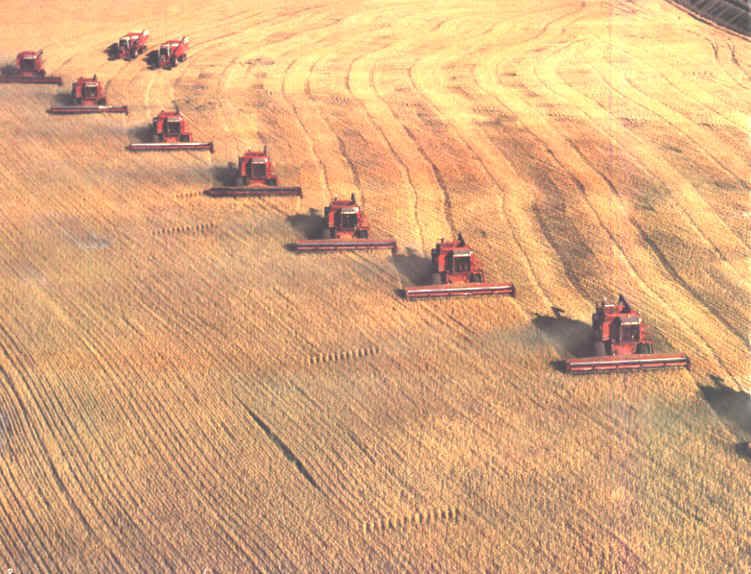
Harvesting line of International Harvester wheat combines, Topeka, Kansas - USA
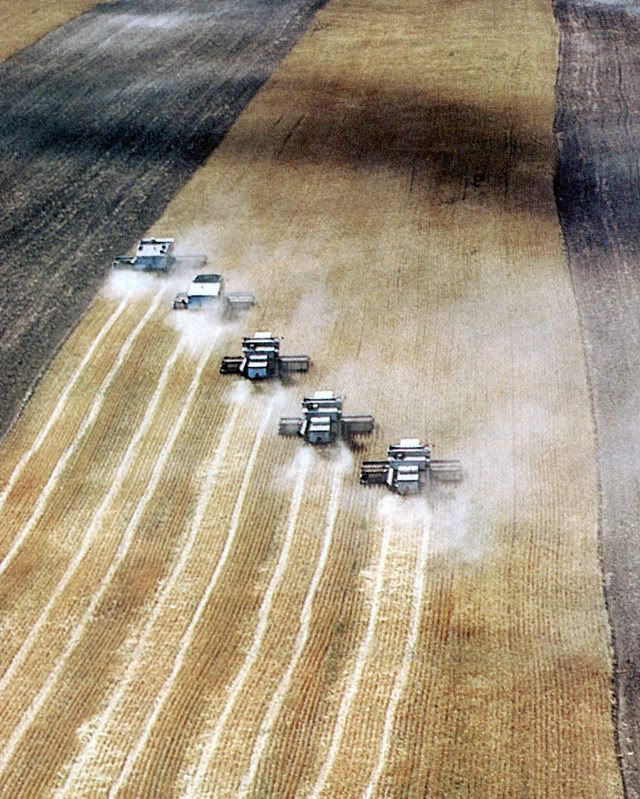
Harvesting line of Rostselymash Don 1500 wheat combines, Pokrovskoye, Donetska Oblast, USSR
You don’t believe that? No problem. For example, specific types of cheese have long been associated with definite geographic and thus socioeconomic regions. New scientific developments have enabled United States manufacturers to reproduce these specific cheeses successfully. It sounds almost incredibly, but American manufacturers have been so successful in imitating Swiss cheese (the whole secret actually was embedded in a curd lifting process from a vat, and the application of the specific micro-organisms which produce the wholes in cheese) that the Swiss producers have joined together to fight the very efficient American competition! 
Introduction of the insulated tank trucks and railroad cars (US patent from 1952), capable to keep milk cold and to speed it safely from dairy farms to city dairy plants, resulted in a great enlargement of the “milkshed” – the area from which a city can obtain its milk, without much more costly condensation, evaporation or powdering procedures. Yet again, socio-economic structure of the given country is completely irrelevant in this case too. (Duncan, A. O: Food processing – Atlanta, Turner E. Smith and Co. – p. 133)
Effects of the Machinery upon Wheat production, for example are totally independent from the socio-economical structures as well – the invention that revolutionized the wheat industry was the reaper, invented by Cyrus McCormick in 1831. This device not only simplified harvesting, but enormously increased the area which a farmer might plant. Today the combine which includes both a reaper and a thresher, makes it possible for the proucer to work wheat areas many times the size of those prior to this invention.
As stated in a truly magnificent report of Mr. Herb Plambeck, Farm Director from the WHO Station in Des Moines, Iowa – who actually have visited USSR in 1962, all Soviet planting practices, administration of nutrients, weed elimination procedures, disease and insect management, irrigation patterns and harvesting techniques, as well as storage operationalization actually represented a slightly modified reproduction of the contiguous American patterns.
If you are interested for this highly intriguing matter, my dear Mr. Kato, I am recommending you some highly accurate and very carefully crafted pieces of painstaking quantitative and qualitative research, but in the very same time also some provocative studies about one of the most perplexing episodes in European history – the history of the development of the Soviet Agro-corporation.
Those significant scientific works were created by two highly renowned Ukrainian scientists, academic work (PhD thesis) by Mr. Volodimir Antonovich Plyotinskii: “The Agro-corporation Down of Communism” (Плютинський Володимир Антонович: Агропромислова корпорація “Зоря комунизму”)

Volodimir Antonovich Plyotinskii, PhD – double Hero of the USSR
And “Collective farm ‘Peremoga’ in Pokrovskii Rayon” by Mr. Ivan Grigorovich Kisenko – (Иван Григорович Кiсенко: “Колгосп ‘Перемога’ в Покровському районi на Днипропетровщинi”).
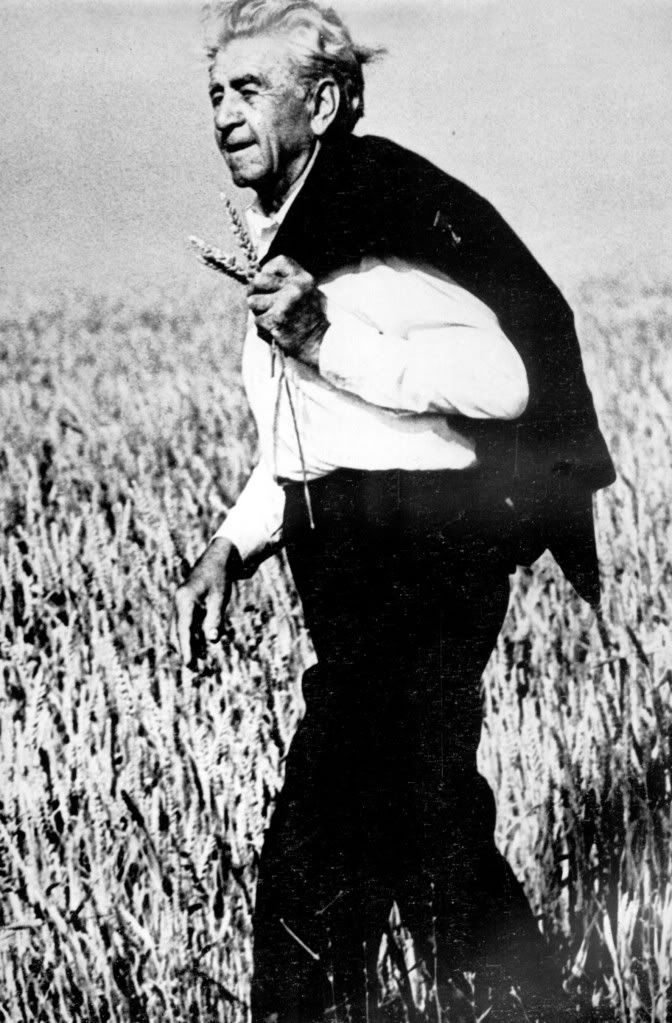
Ivan Grigorovich Kisenko, PhD
To be continued…:roll:
Those magnificent pieces of unrestrained scientific work are still available in the Vernadsky National Library of Ukraine. Therefore if you wish we will be able to compare every single step of agricultural production in the former USSR and USA. In this very moment I am waiting for a truly magnificent book “Farm machinery and equipment” by Harris Pearson Smith (1965, Mc Graw-Hill, Inc.). And it will be here soon! 
It is tendentious interpretation.
Sorry, my dear Mr. Kato – actually it represents only a concise summarization of numerous materials, governmental reports, scientific studies, etc.
Bolsheviks inherited the industrial basis of the Russian Empire. Yes, the industry of the Russian Empire wasn’t the most powerful in the world but it rather closely followed the national industries of the leading countries.
Alas, not even closely, my dear mr. Kato. Here you have the more colorful presentation of the factual share of the Russian industrial production. Please, take a closer look:
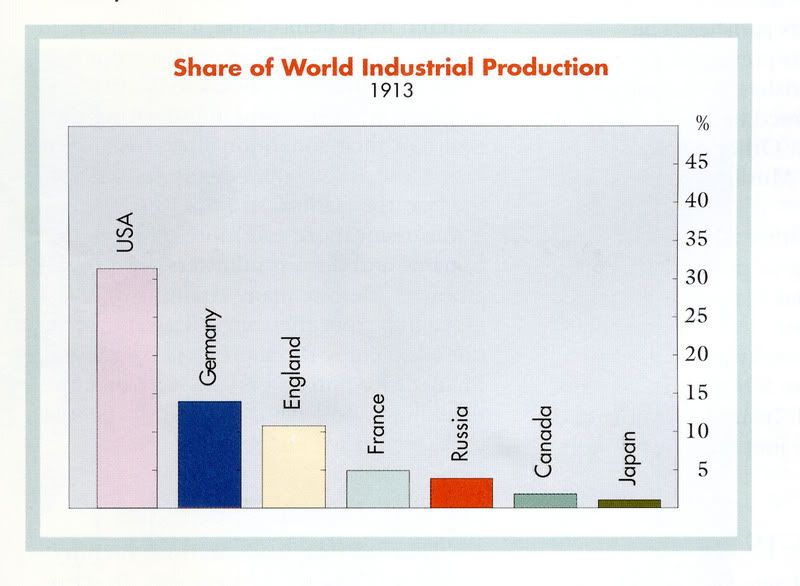
“Russia then and now”, Phyllis A. Arnold & David J. Rees. – p. 72
As to primitive peasant economy, one may object that nearly all the European states (even France and partly Germany) had peasant economies (majority of the population involved in agriculture) in the 1920s.
Alas, that was not the case, my dear Mr. Kato. Here you have the full comparative presentation of the societal stratification in the Czarist Russia:

Czarist Russia – societal structure
… in the Soviet Union…
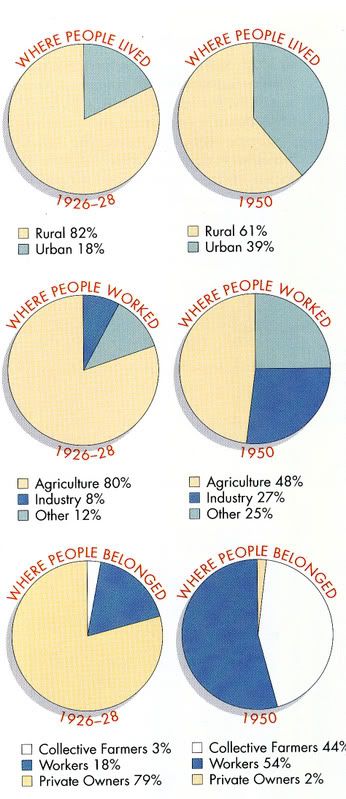
Soviet Union – societal structure
… and official German records are presented here:
http://germanhistorydocs.ghi-dc.org/pdf/eng/103_Occupational%20Breakdown_3.pdf
Please, compare those numbers. As far as I can see there is no similarity between Germany and Russia in this specific field.
The words “with hardly any outside help” are also wrong because the USSR concluded trade, economic and political agreements with all the leading countries and it wasn’t economically isolated.
My dear Mr. Kato, status of the participant in the foreign trade is not identical with the status of the recipient of foreign economic aid. Recipient of foreign aid legally is a country or some other collective entity that is bestowed by different grants – natured in cash or in some other category of value - for which the recipient incurs no legal or ulterior debt toward grantor.
Any foreign statistics of AnnualIncomePerCapita and Production indicators can be generared on the basis of the Soviet statistics. Foreign institutions were simply unable to make up surveys in such a closed country like the USSR.
Well then, my dear Mr. Kato, tell me, please the names of those independent international institutions or officially competent personalities which actually supervised and controlled factual accuracy of the Tunisian governmental statistics in 1938, as well as the applied methodology in those independent multinational statistical supervision activities back there in a beautifully opened and utterly transparent state called Czarist Russia, in the Year of our Lord 1881. Those statistics are for ever and a day OK by default, aren’t they?
In the meantime I will tell you the names of the persons who actually supervised the factual data-accuracy of the Soviet statistical evaluations: Dr. Paul C. Rosenbloom, Professor of mathematics at the University of Minnesota, and Professor Dr. Abram Bergson and his colleagues at Columbia, Harvard, and the RAND Corporation.
But even if these figures were adequate, they are just general indicators that can’t give the idea about the proporion of national wealth distributed among ordinary population and retained by the state that pay miserable sallaries, owned all the means of production and even the living premises of its citizens.
The estimation methods used by US governmental agencies always were and still are highly advanced ones, my dear Mr. Kato. The numerous facts, complexity of correlations that exist in the strategic raw data-indicators usually do not allow a man to find out something more about factual situation within a given country. However, some mathematical wonders are capable to reduce the fond of abstrusities to the dimensions that are surmountable and sufficiently accurate.
For example, a simple non-parametric technique, based on the so called Kolmogorov-Smirnov test will be able to determine if two different datasets differ significantly. The KS-test has the advantage of making no assumption about the distribution of data, so we will be obliged just to examine are the Soviet data sets susceptible to a lognormal distribution or not. Therefore – at least theoretically – veracity examination of the Soviet statistics was achievable.
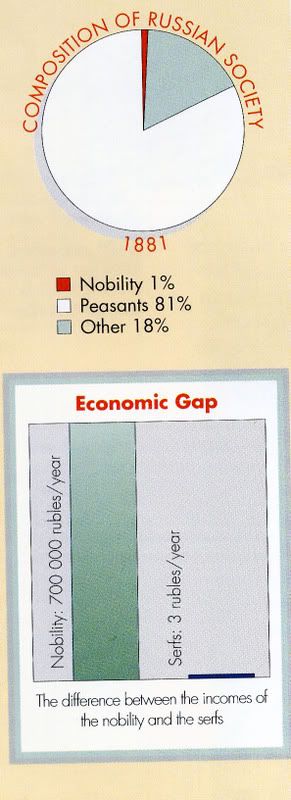
Czarist Russia – Income Gap
As a mater of fact, income distribution in the USSR was more equal than in the Western countries, except Sweden (N. E. Rabkina and N. M. Rimashevskaia, 1972 aned 1978, quoted in A Note on the Distribution of Earnings in the USSR under Brezhnev by Michael Ellman - (“Slavic Review”, Vol. 39, No. 4 [Dec., 1980], pp. 669-671).
Despite the fact that Soviet compensation schemes varied upon experience, rank and education, and even though Soviet policies on earnings fluctuated over time, employees in the Soviet Union were more fairly compensated than their counterparts in the West. Individual wealth was limited to a small number of private housing units, cooperatives, agricultural plots, consumer durables, and savings. Please, just follow this link:
http://www.wider.unu.edu/wiid/data/SUN.htm
The subsequent graph, taken from highly intriguing study undertaken by some highly original physicist (http://www2.physics.umd.edu/~yakovenk/econophysics/) indicates that the developing earnings conditions in the modern times are not dispassionately preferable for the majority of the population. This conclusion is supported by the rise in income inequality experienced in these nations after social system alteration, and the relatively high level of the stability of income inequality that is shown in other capitalist nations.
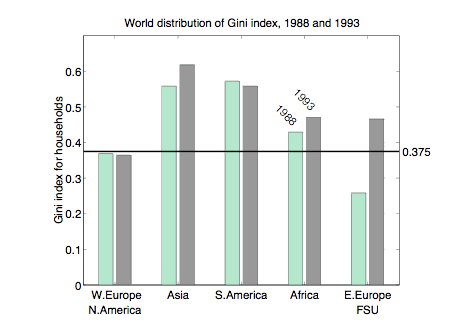
World distribution of Gini index, 1988 and 1993 - Adrian A. Dragulescu and Victor M. Yankovenko2002, "Statistical Mechanics of Money, Income and Wealth: A Short Survey” (AIP Conference, Proceedings - 661)
Original work is presented here:
http://www2.physics.umd.edu/~yakovenk/papers/income.pdf
Enjoy!